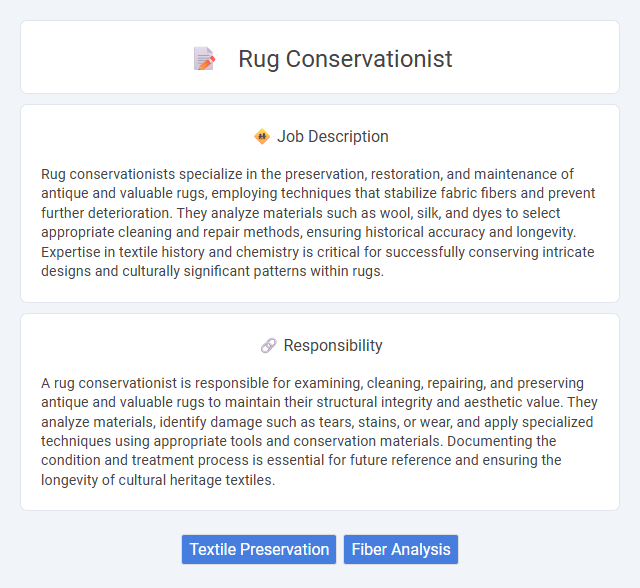
Rug conservationists specialize in the preservation, restoration, and maintenance of antique and valuable rugs, employing techniques that stabilize fabric fibers and prevent further deterioration. They analyze materials such as wool, silk, and dyes to select appropriate cleaning and repair methods, ensuring historical accuracy and longevity. Expertise in textile history and chemistry is critical for successfully conserving intricate designs and culturally significant patterns within rugs.
Individuals with strong attention to detail and patience are likely to be suitable for a rug conservationist job, as the role requires meticulous handling of delicate textiles. Those who may struggle with fine motor skills or have limited interest in historical preservation might find this job challenging. Physical endurance is also important due to the often prolonged periods of standing and working with intricate materials.
Qualification
Rug conservationists typically require a background in textile conservation or a related field, with qualifications such as a degree in art conservation, textile science, or museum studies. Specialized training in fiber analysis, stain removal, and restoration techniques is essential for preserving antique and valuable rugs. Proficiency in handling delicate fibers, understanding historical rug materials, and knowledge of conservation ethics enhances effectiveness in this role.
Responsibility
A rug conservationist is responsible for examining, cleaning, repairing, and preserving antique and valuable rugs to maintain their structural integrity and aesthetic value. They analyze materials, identify damage such as tears, stains, or wear, and apply specialized techniques using appropriate tools and conservation materials. Documenting the condition and treatment process is essential for future reference and ensuring the longevity of cultural heritage textiles.
Benefit
Rug conservationists likely enhance the longevity and cultural value of antique and delicate rugs by applying specialized preservation techniques. They probably increase the market value and aesthetic appeal of rugs through careful restoration, which may attract collectors and museums. Their expertise could also contribute to educating the public about textile heritage, fostering a deeper appreciation for traditional craftsmanship.
Challenge
The role of a rug conservationist likely involves the challenge of balancing preservation with restoration, as delicate fabrics require meticulous care to avoid further damage. There is a significant probability that identifying original materials and techniques poses difficulties due to age and wear. Conservators often face uncertainties in selecting appropriate methods that maintain historical integrity while ensuring long-term durability.
Career Advancement
Rug conservationists specialize in the preservation and restoration of antique and delicate rugs, applying expert techniques to maintain textile integrity and historical value. Career advancement opportunities include roles such as senior conservator, museum textile specialist, or consultancy positions in cultural heritage preservation. Developing skills in advanced textile analysis, restoration technology, and historical textile research significantly enhances job prospects and professional growth in this field.
Key Terms
Textile Preservation
Rug conservationists specialize in textile preservation by meticulously restoring and stabilizing antique and culturally significant rugs to prevent further deterioration. They employ techniques such as cleaning, reweaving, and reinforcing fibers using historically accurate materials to maintain the rug's authenticity and structural integrity. Expertise in fiber analysis, dye chemistry, and environmental control ensures long-term preservation of valuable textiles in museum or private collections.
Fiber Analysis
Rug conservationists specializing in fiber analysis examine the material composition of antique textiles to determine their origin, age, and condition. Utilizing microscopy and chemical tests, they identify fiber types such as wool, silk, or cotton to guide appropriate cleaning and restoration methods. Precise fiber analysis ensures the preservation of historical authenticity and structural integrity in delicate rugs.
 kuljobs.com
kuljobs.com